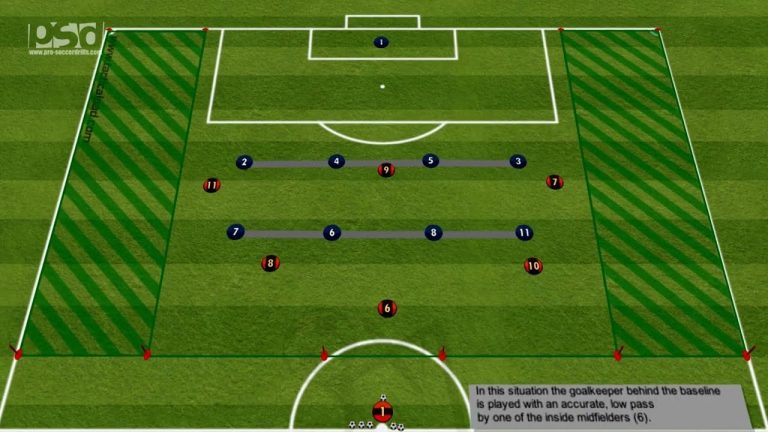In the fast-paced world of modern football, the ability to quickly transition from attack to defense has become a pressing concern for teams at all levels. The defensive phase of the game is where matches can be won or lost, and mastering the art of defensive transitions has become a key aspect of success on the pitch. In this article, we delve into the intricacies of this vital skill, exploring the tactics, strategies, and individual responsibilities that contribute to a team’s ability to seamlessly shift from attacking to defensive positions. Join us as we uncover the secrets behind effective defensive transitions and discover how they can make all the difference in the outcome of a match.
What does defensive press refer to?
Defensive press is a strategic tactic employed by the defending team to apply intense pressure on the opponent in possession of the ball. By doing so, they aim to limit the time available for the opponent to construct plays and disrupt their rhythm, ultimately aiming to induce turnovers. This aggressive approach can be highly effective in unsettling the opposing team and gaining a significant advantage in the game.
The essence of defensive press lies in the ability to suffocate the opponent’s progress on the field. The defending team relentlessly pushes forward, closing down passing lanes and applying relentless pressure on the ball carrier. This not only disturbs the opponent’s ability to build up attacks but also creates opportunities for interceptions and counter-attacks. The defensive press demands disciplined teamwork, coordination, and quick decision-making to successfully execute this high-intensity strategy.
When executed with precision, defensive press can be a game-changer. By disrupting the opponent’s rhythm and forcing turnovers, the defending team can quickly transition from defense to offense and create scoring opportunities. Additionally, the constant pressure exerted by the defensive press can mentally exhaust the opponent, making them prone to errors and poor decision-making. As a result, defensive press has become a popular tactic in modern football, admired for its ability to dominate games and turn the tide in favor of the defending team.
What is the meaning of defensive transition?
Defensive transition is the pivotal moment when a team shifts from an attacking mindset to a defensive one after losing possession of the ball. It occurs at any position on the field and necessitates various strategies to effectively regain defensive shape.
What does counterpressing mean?
Counter-pressing, also known as defensive transition, is a powerful strategy employed to immediately disrupt the opposition upon losing possession. This dynamic tactic entails a proactive approach, where multiple players aggressively press the ball and the opponents in close proximity. By swiftly closing down the opposition, counter-pressing aims to regain control of the ball and prevent the opponents from launching effective attacks, making it a vital weapon in modern football.
Mastering Defensive Transitions: Unleashing the Power of Pressing
Paragraph 1:
“Mastering Defensive Transitions: Unleashing the Power of Pressing”
In the high-octane world of sports, mastering defensive transitions is the key to unlocking the true power of pressing. In this dynamic strategy, teams seamlessly transition from offense to defense, putting intense pressure on their opponents and disrupting their rhythm. By honing this skill, players can effectively shut down the opposition’s attacks, regain possession, and launch counter-attacks with lightning speed. With precise positioning, quick decision-making, and relentless teamwork, mastering defensive transitions can become a game-changer on the field, leading teams to victory.
Paragraph 2:
Discover the art of unleashing the power of pressing through mastering defensive transitions. As players seamlessly switch from offense to defense, they become a formidable force that strikes fear into their opponents. By applying intense pressure, disrupting their rhythm, and regaining possession swiftly, teams can dictate the course of the game. With each player strategically positioned, making split-second decisions, and working in perfect harmony, the power of pressing becomes a force to be reckoned with. Unleash your team’s potential and dominate the field by mastering defensive transitions – the game-changer that will bring you closer to victory.
Cracking the Code: Defensive Transitions for Winning Pressing Strategies
Paragraph 1:
In the world of soccer, mastering defensive transitions is the key to success when implementing pressing strategies. The ability to seamlessly shift from attacking to defending can make or break a team’s chances of winning. By cracking the code of defensive transitions, coaches can unlock a powerful weapon that disrupts the opponent’s flow and creates scoring opportunities. Developing a cohesive and disciplined system is crucial, ensuring every player understands their role and can execute the pressing strategy flawlessly.
Paragraph 2:
A winning pressing strategy requires a deep understanding of the opponent’s patterns and tendencies. Coaches must analyze their rival’s playing style, identifying potential weaknesses that can be exploited during defensive transitions. By studying their movement off the ball, passing patterns, and key players, teams can effectively disrupt their game plan and regain possession. This information is the code that, once cracked, enables a team to execute defensive transitions with precision and efficiency.
Paragraph 3:
To crack the code of defensive transitions, teams must prioritize communication and teamwork. Coordinated movements and quick decision-making are essential for a successful pressing strategy. Each player must be aware of their surroundings, anticipating the opponent’s next move and adjusting their positioning accordingly. By fostering a culture of collective responsibility, teams can ensure every player is actively involved in defensive transitions, making it harder for the opponent to break through their defensive line. Ultimately, cracking the code of defensive transitions leads to more victories and a stronger, more resilient team.
From Defense to Attack: The Art of Seamless Transitions in Pressing
From Defense to Attack: The Art of Seamless Transitions in Pressing
1) In the world of soccer, pressing is an essential tactic that can turn defense into a powerful offensive weapon. The art of seamless transitions lies in the ability to quickly shift from a defensive stance to a relentless attacking force. Teams that master this art can catch their opponents off guard and create numerous goal-scoring opportunities. By pressing high up the pitch, players can disrupt the opposition’s build-up play, win back possession, and launch swift counter-attacks. This seamless transition requires exceptional teamwork, communication, and a deep understanding of the game.
2) The key to successful pressing lies in the synchronization of players’ movements and actions. When a team decides to press, every player must be aware of their responsibilities and execute their tasks with precision. The defenders push forward to close down the opponent’s passing options while the midfielders and forwards apply pressure on the ball carrier. This coordinated effort creates a web of intense pressure, forcing mistakes and turnovers. It is crucial for players to maintain discipline and avoid leaving gaps in the defensive structure. Seamless transitions require constant communication and anticipation, ensuring that the team remains compact and organized.
3) Timing is everything when it comes to pressing. A well-executed press is not only about intensity but also about the right moment to engage. Players must carefully read the game, assess the opponents’ positioning, and choose the opportune moment to initiate the press. By pressing at the right time, a team can disrupt the opposition’s rhythm and force them into making errors. This tactical approach demands high levels of concentration and awareness from every player on the field. It is through these seamless transitions that teams can transform their defensive efforts into potent attacks, leaving their opponents struggling to cope.
Unlocking Success: The Crucial Role of Defensive Transitions in Pressing
Unlocking Success: The Crucial Role of Defensive Transitions in Pressing
In the world of sports, success often hinges on the ability to seamlessly transition from defense to offense. Nowhere is this more evident than in the art of pressing, where unlocking success relies heavily on effective defensive transitions. When a team presses their opponents, it requires a collective effort to quickly regain possession after losing the ball. This is where defensive transitions come into play, as players must swiftly switch from an attacking mindset to a defensive one. By mastering the art of defensive transitions, teams can disrupt their opponents’ rhythm, create scoring opportunities, and ultimately unlock the key to success on the field.
The beauty of defensive transitions lies in their ability to turn defense into offense in the blink of an eye. As soon as a team loses possession, players must immediately shift their focus to quickly regaining control. This requires not only individual discipline but also a deep understanding of each teammate’s role in the pressing system. By seamlessly transitioning from attack to defense, teams can catch their opponents off guard, forcing them into mistakes and opening up gaps in their defense. These split-second transitions are the crucial link that unlocks success in pressing, allowing teams to maintain a relentless and high-intensity style of play that keeps their opponents on their toes.
In the fast-paced world of modern football, the ability to effectively press in defensive transitions has become a crucial aspect of any successful team’s game plan. By seamlessly transitioning between attack and defense, teams can disrupt their opponents’ rhythm, win back possession, and launch quick counter-attacks. In this ever-evolving sport, mastering the art of pressing in defensive transitions is not only a necessity but also a strategic advantage that can make the difference between victory and defeat. With its ability to unsettle even the most formidable opponents, this pressing tactic has emerged as a game-changer in the beautiful game.



